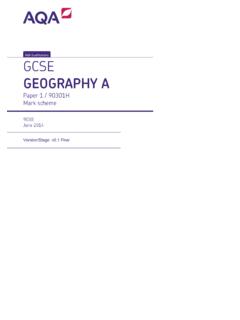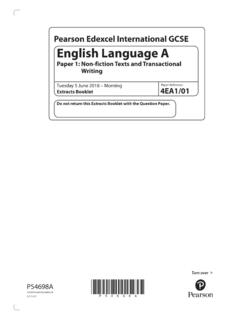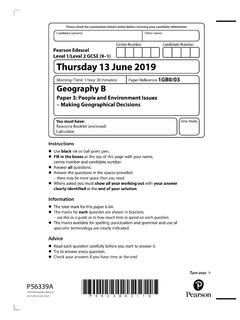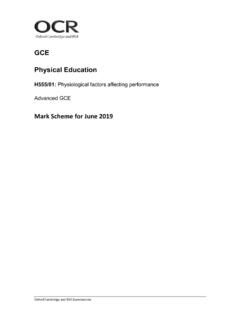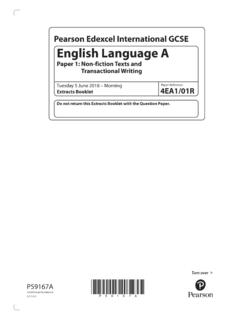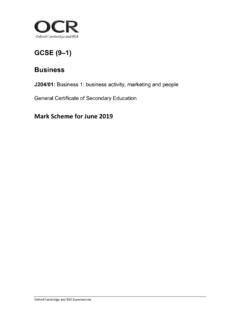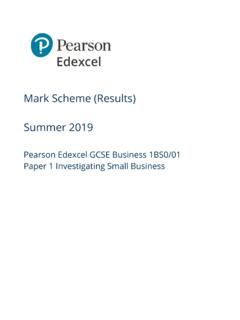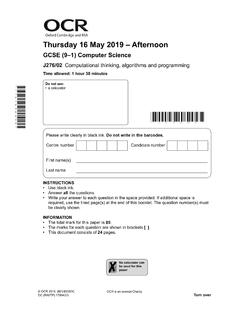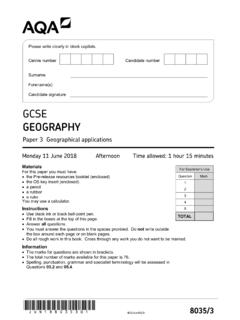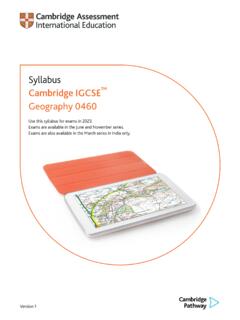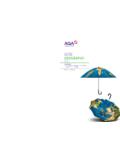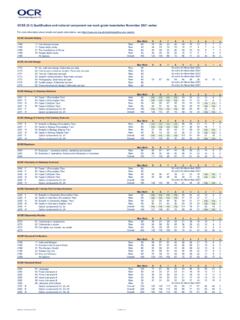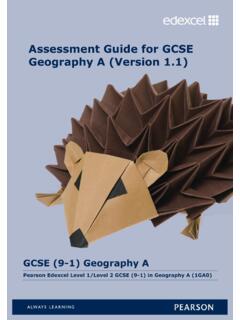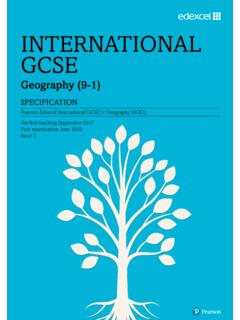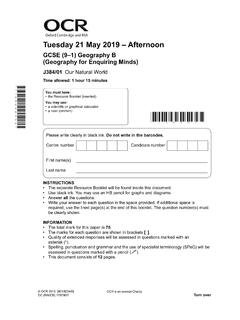Transcription of Candidate surname Other names
1 Please check the examination details below before entering your Candidate information Candidate surname Other names Centre Number Candidate Number Pearson Edexcel Level 1/Level 2 gcse (9 1). Thursday 11 June 2020. Morning (Time: 1 hour 30 minutes) paper Reference 1GA0/03. geography A. paper 3: geographical Investigations: Fieldwork and UK Challenges You must have: Total Marks Resource Booklet (enclosed). Calculator Instructions Use black ink or ball-point pen. centre Fill in the boxes at the top of this page with your name, number and Candidate number. In Section AB answer In Section answer either Question 1 or Question 2. In Section C answer either Question 3 or Question 4. Answer the questionsallinquestions. there may be more spacethethanspaces provided you need. Where asked you must show all your working out with your answer clearly identified at the end of your solution.
2 Information The total mark for this paper is 64. The marks for each question are shown in brackets use this as a guide as to how much time to spend on each question. The marks available for spelling, punctuation, grammar and use of specialist terminology are clearly indicated. Advice Read each question carefully before you start to answer it. Check your answers if you have time at the end. Turn over *P62021A0124*. P62021A. 2020 Pearson Education Ltd. 1/1/1/1/1/1/1. Some questions must be answered with a cross in a box . If you change your mind about an answer, put a line through the box and then mark your new answer with a cross . SECTION A. geographical Investigations Physical Environments Answer EITHER Question 1 OR Question 2 in this section. Write your answers in the spaces provided. Question 1: Investigating Physical Environments (Rivers).
3 If you answer Question 1 put a cross in the box . 1 A group of students collected data to investigate changes at five sites along a river channel. (a) Study Figure 1a below. (Source: Andy Childe). Figure 1a Students collecting river data 2. *P62021A0224*. (i) Describe one fieldwork method that could be used by the students to measure river width. (2).. (ii) Explain one disadvantage of using this data collection method. (2).. (b) Study Figure 1b in the Resource Booklet. (i) Calculate the mean width of the river. Give your answer to two decimal places. You must show your working in the space below. (2).. m (ii) Explain one conclusion that could be drawn from the data in Figure 1b. (2).. 3. *P62021A0324* Turn over (c) The students measured sediment size at each site and presented data in a bar chart. Study Figure 1c below.
4 200. 180. 160. 140. Mean sediment size (mm). 120. 100. 80. 60. 40. 20. 0. Site 1 Site 2 Site 3 Site 4 Site 5. Survey sites Figure 1c Plot the data from the table below on to Figure 1c. (2). Survey site Mean sediment size (mm). Site 3 96. Site 4 80. 4. *P62021A0424*. (d) You have studied a river as part of your geographical investigation. Evaluate the effectiveness of the different techniques used to present your fieldwork data. (8). Title of your geographical investigation .. 5. *P62021A0524* Turn over .. (Total for Question 1 = 18 marks). 6. *P62021A0624*. Do not answer Question 2 if you have answered Question 1. Question 2: Investigating Physical Environments (Coasts). If you answer Question 2 put a cross in the box . 2 A group of students collected data to investigate coastal processes at five sites along a coast.
5 (a) Study Figure 2a below. (Source: Andy Childe). Figure 2a Students collecting coastal data (i) Describe one fieldwork method that could be used by the students to measure beach gradient. (2).. 7. *P62021A0724* Turn over (ii) Explain one disadvantage of using this data collection method. (2).. (b) Study Figure 2b in the Resource Booklet. (i) Calculate the mean sediment size. Give your answer to one decimal place. You must show your working in the space below. (2).. mm (ii) Explain one conclusion that could be drawn from the data in Figure 2b. (2).. 8. *P62021A0824*. (c) The students measured sediment size at each site and presented data in a bar chart. Study Figure 2c below. 10. 9. 8. 7. Mean sediment size (mm). 6. 5. 4. 3. 2. 1. 0. Site 1 Site 2 Site 3 Site 4 Site 5. Survey sites Figure 2c Plot the data from the table below on to Figure 2c.
6 (2). Survey site Mean sediment size (mm). Site 3 3. Site 4 2. 9. *P62021A0924* Turn over (d) You have studied a coast as part of your geographical investigation. Evaluate the effectiveness of the different techniques used to present your fieldwork data. (8). Title of your geographical investigation .. 10. *P62021A01024*.. (Total for Question 2 = 18 marks). TOTAL FOR SECTION A = 18 MARKS. 11. *P62021A01124* Turn over SECTION B. geographical Investigations Human Landscapes Answer EITHER Question 3 OR Question 4 in this section. Write your answers in the spaces provided. Question 3: Investigating Human Landscapes (Central/Inner Urban Area). If you answer Question 3 put a cross in the box . 3 (a) You have studied an urban area as part of your own fieldwork. (i) Explain one reason why you used a qualitative fieldwork method.
7 Named qualitative fieldwork method .. (2).. (ii) Explain one disadvantage of this qualitative fieldwork method. (2).. (b) State one risk that you considered before collecting your urban fieldwork data. (1).. 12. *P62021A01224*. (c) Explain one advantage of a sampling strategy you used to collect your data. Use evidence from your own fieldwork in your answer. Named sampling strategy .. (2).. (d) Explain one way in which the secondary data that you collected helped your urban investigation. Named secondary source .. (3).. 13. *P62021A01324* Turn over (e) Study Figures 3a and 3b in the Resource Booklet. Using both Figures 3a and 3b, assess the conclusions that might be drawn from this urban investigation. (8).. 14. *P62021A01424*.. (Total for Question 3 = 18 marks). 15. *P62021A01524* Turn over Do not answer Question 4 if you have answered Question 3.
8 Question 4: Investigating Human Landscapes (Rural Settlements). If you answer Question 4 put a cross in the box . 4 (a) You have studied a rural settlement as part of your own fieldwork. (i) Explain one reason why you used a qualitative fieldwork method. Named qualitative fieldwork method .. (2).. (ii) Explain one disadvantage of this qualitative fieldwork method. (2).. (b) State one risk that you considered before collecting your rural fieldwork data. (1).. 16. *P62021A01624*. (c) Explain one advantage of a sampling strategy you used to collect your data. Use evidence from your own fieldwork in your answer. Named sampling strategy .. (2).. (d) Explain one way in which the secondary data that you collected helped your rural investigation. Named secondary source .. (3).. 17. *P62021A01724* Turn over (e) Study Figures 4a and 4b in the Resource Booklet.
9 Using both Figures 4a and 4b, assess the conclusions that might be drawn from this rural investigation. (8).. 18. *P62021A01824*.. (Total for Question 4 = 18 marks). TOTAL FOR SECTION B = 18 MARKS. 19. *P62021A01924* Turn over SECTION C. UK Challenges Answer ALL questions in this section. Write your answers in the spaces provided. Spelling, punctuation, grammar and specialist terminology will be assessed in Question 5(f). 5 (a) Study Figure 5a in the Resource Booklet. Identify the offshore wind energy capacity in 2015. (1). A 2000 megawatts B 3000 megawatts C 4000 megawatts D 5000 megawatts (b) State two impacts of climate change on landscapes in the UK. (2).. 20. *P62021A02024*. (c) The UK government has increased the use of renewable energy. In 2011, UK energy use from renewables was equivalent to burning million tonnes of oil whereas in 2017 it was million tonnes.
10 Calculate the percentage (%) increase in energy use from renewables between 2011 and 2017. Give your answer to the nearest whole number. You must show your working in the space below. (2).. %. (d) Explain two impacts of climate change on people in the UK. (4).. 21. *P62021A02124* Turn over (e) One response to climate change in the UK is the development of sustainable transport schemes. Explain one example of a sustainable transport scheme in the UK. (3).. 22. *P62021A02224*. In this question, up to four additional marks will be awarded for your spelling, punctuation, grammar and your use of specialist terminology. (f ) Use the information from the Resource Booklet (Figures 5a to 5d) as well as knowledge and understanding from the rest of your geography course. The use of local scale responses is less important than national scale responses in tackling the challenges of climate change in the UK.
